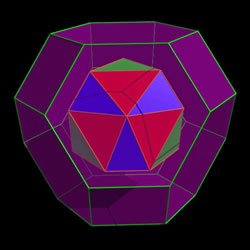 En geometria tridimensional, un sòlid arquimedià, al igual que un de platònic (d’aquests n’hi ha cinc: tetraedre, octaedre, cub, icosaedre i dodecahedre) té tots els vèrtexs idèntics. Però així com els sòlids platònics tenen totes les cares i arestes també iguals, els sòlids arquimedians tenen dos o més tipus de cares (i d’arestes).
En geometria tridimensional, un sòlid arquimedià, al igual que un de platònic (d’aquests n’hi ha cinc: tetraedre, octaedre, cub, icosaedre i dodecahedre) té tots els vèrtexs idèntics. Però així com els sòlids platònics tenen totes les cares i arestes també iguals, els sòlids arquimedians tenen dos o més tipus de cares (i d’arestes).
Precisament Chemistry World (Chemists create a molecular ship in a bottle) acaba de publicar un interessant post que comenta un article de Science de química supramolecular: Supramolecular Archimedean Cages Assembled with 72 Hydrogen Bonds. Es tracta de gàbies d’octaedres truncats formades per cares unides per enllaços covalents i també per 72 enllaços d’hidrogen. A dins d’aquestes gàbies hi poden haver molècules neutres, carregades… una mica com un vaixell dins d’una ampolla. Les gàbies s’uneixen entre sí per formar estructures semblants a les de les zeolites.
De fet, hi ha dues peces que ajuden a autoensamblar aquesta estructura arquimediana, gràcies als ponts d’hidrogen entre grups N-H d’una peça i grups O-S de l’altra:
The first tile consists of a tris(guanidinium) nitrate cluster, and the second a hexa(4-sulfonatophenyl) benzene. When the appropriate precursors are placed in solution, four of each type of tile self-assemble through an eyebrow-raising 72 hydrogen bonds between N-H groups of one type of tile and the O-S of the other.
Segons Chemistry World,
The cages, each a truncated octahedron, connect with each other to form zeolite-like crystals with each unit having an internal cavity volume of 2200Å3. The team demonstrated that the cavities could host a wide range of molecular entities of varying charge, ranging from 10 negative charges to four positives. ‘It is very unusual to find a framework which will accommodate both positive or negatively charged guests,’ Ward says. While some of the molecules apparently enter the cages through square channels, which are an inherent part of the geometry, others are too large and are either encapsulated during assembly of the cage or else assemble once inside – the molecular equivalent of a ship in a bottle.
i també
‘This is impressive work,’ says Scott Dalgarno, who heads the supramolecular research group at Heriot-Watt University in the UK. ‘Supramolecular chemists will find this important as it extends the previous approaches to make a really elegant hydrogen-bonded system that shows real versatility in its ability to encapsulate things. It is not always straightforward to encapsulate guests and this range was diverse.’ Dalgarno adds: ‘Alteration of the components will likely produce a series of stable polyhedra that will display similar stability and versatility, and will permit a range of functions.’

Al Chemistry World hi ha un bonic video on es mostres aquestes superestructures: http://www.youtube.com/watch?v=Mwn6cTVZWxo
Aquesta idea fa recordar una síntesi de fa alguns anys, sobre una “pilota de tennis” que també podia encapsular molècules, que de fet fins i tot ha esdevingut una pràctica de laboratori: Synthesis and Self-Assembly of the “Tennis Ball” Dimer and Subsequent Encapsulation of Methane. An Advanced Organic Chemistry Laboratory Experiment